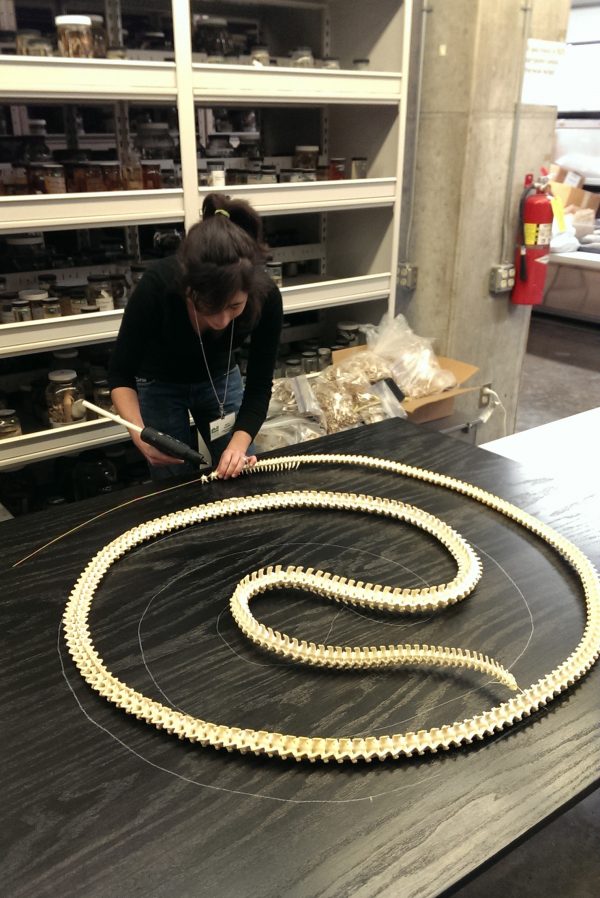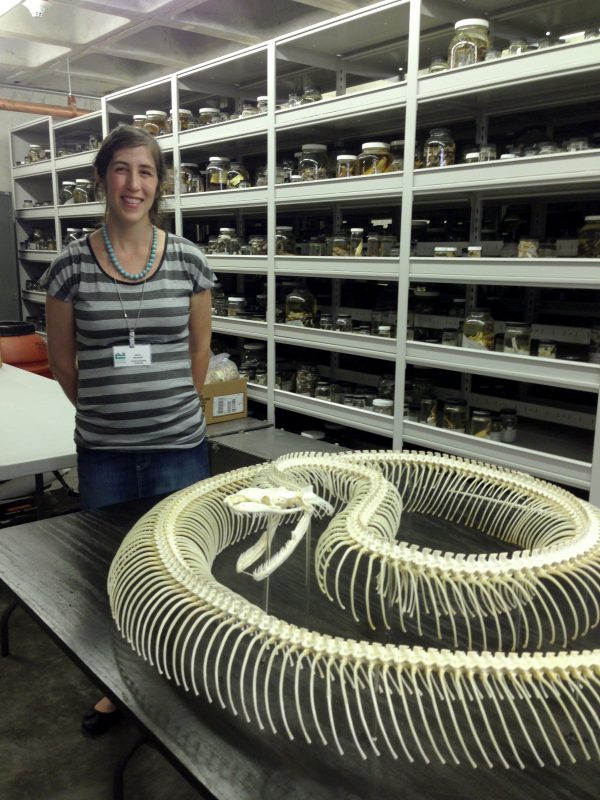
Florida Museum of Natural History photo by Kenneth Krysko
As Becky Reichart pressed against one of the sleek, bleached, white rib bones of the fully rearticulated 17-foot-7-inch Burmese python, one of the largest found in Florida, she commented, “They look delicate, but they’re actually really strong.”
The bones tell the story of the snake’s life in the Everglades of South Florida, where it thrived and survived injury. Florida Museum of Natural History herpetology collections assistant and University of Florida graduate student Leroy Nuñez pointed to healed fractures on the ribs of a snake that he says bounced back from nearly everything life threw at her.
“We literally got to know this animal from the inside out,” Nuñez said. “She was so incredibly resilient. This was an older snake. She’d been around for a while, and she took a beating. We can see that some of ribs have fused together after an injury. It didn’t even appear to phase her.”
Alive, the python’s 165-pound body slithered through the murky swamps of the Everglades, likely its birthplace, for several years; a descendant of exotic pets released into the wild by humans. A September 2011 study by Florida Museum herpetology collection manager Kenneth Krysko found the exotic pet trade to be the No. 1 cause of invasive species introductions. Originating in Southeast Asia and making its way to the Everglades in 1979, the Burmese python resides near the top of the food chain in South Florida, mostly because nothing other than humans and alligators can cause it harm.
Reichart, a Florida Museum volunteer, began the painstaking work of reassembling the snake’s 872 ribs and vertebrae, its skull and more than 100 teeth in February 2014. She began with the vertebrae, carefully placing each on preformed tapered wire, connecting them with hot glue beginning with the first vertebrae and ending with the 338th.
That was the easy part.
“The ribs were just not sticking to the vertebrae,” Reichart said. “It was a matter of trial and error to find what adhesive worked best. There were times when I spent hours gluing on the ribs, just for them to pop off.”
Krysko, an avid fly fisherman, thought of trying a special dental acrylic he uses to make fly-fishing lures. After they found this adhesive worked, it was still tough determining how the ribs should be placed, as they naturally move in different directions.
“It was frustrating,” Reichart said. “As soon as I thought we were making progress, we would find a mistake in the positioning of the ribs and have to start over.”
Some of the snake’s teeth came loose and had to be glued in as Reichart reconstructed its skull. The python’s skull looks small compared to the rib bones that expand outward toward the middle of the body. When it was alive, its jaw would open widely to swallow prey and its body expanded to accommodate larger animals.
Rearticulating the bones piece by piece required nearly four months and more than 250 hours of Reichart’s tedious attention to detail. But the bones’ journey to their current immaculate condition took even longer.
The Necropsy of a Burmese Python
Two years before Reichart completed the rearticulation, the python was shipped to the museum after being captured and euthanized in Everglades National Park. The frozen specimen thawed over several days in preparation for the necropsy, which is the autopsy of an animal. Nuñez remembers someone saying, “Well that’s a big snake” as four researchers picked up the enormous python and laid it across three 8-foot-long tables.
The dissection was completed by teams, with each assigned particular sections of the snake.
“I thought of it like fileting a huge fish,” Reichart said.
“But instead of fileting a salmon or something, you’re fileting a 17-foot python,” Nuñez said. “These snakes have a lot of meat, too, so we had to separate the meat from the skin as much as we could using a small scalpel.”
The researchers were careful not to puncture organs like the bladder and liver, because such an accident would induce a putrid smell.
“Except for when an organ is punctured, I do not really notice the smell,” said Nuñez, while standing in the herpetology range of the Florida Museum where hundreds of thousands of specimens sit in jars on rows of shelves. “Maybe some regular person who is not surrounded by dead things all day would find it unpleasant, though.”
Researchers completed the main necropsy in one day. Because Burmese pythons are an invasive species in Florida, scientists were interested in the snake’s stomach contents to see what it had been eating. It’s already known pythons prey on birds, rats, alligators, deer and many other native animals.
In the gastrointestinal tract, researchers found remains mostly digested beyond recognition along with bird feathers from a Black Vulture, Coragyps atratus. After further dissection, scientists discovered the python was carrying a clutch of 87 eggs, a state record.

Florida Museum photo by Stephenie Livingston
“They were large eggs around the size of two golf balls each,” Reichart said. “The number of eggs was probably the most surprising thing we found.”
The large clutch shows how quickly Burmese pythons can reproduce, another concern considering the animal has no natural predators in the Everglades.
The python’s skin was removed over the course of eight hours. After separating most of the skin from the meat, Nuñez held the python’s head while others pulled away the skin.
“But you’re supposed to hold it by the neck, not the head,” Nuñez said. “I ended up accidently getting ‘bitten.’ ”
He pointed to the python’s razor sharp teeth.
“When you’re bitten by a python, it hurts really bad,” he said. “Their jaws are designed in a way that the teeth curve backward, so when you try to try to get away, it just sinks in deeper and you bleed a lot.”
Tanning the skin took several days and required many steps, including soaking it overnight in chemicals used in the tanning process. The skin is now on display at Everglades National Park.
Post-necropsy there remained only meat-covered bones and connective tissue. The 87 eggs were stored in formalin-filled jars. Researchers and volunteers used scalpels to clean as much meat as possible from the 872 bones.
“It was a slow process because the bones are relatively small,” Reichart said.
The snake’s body was divided into sections and sent to the museum’s special projects lab. For the next 10 months, a colony of dermestid beetles gorged on the remaining dried tissue, resulting in nearly white bones. The sections were then fumigated and returned to the herpetology range to soak in peroxide to loosen any remaining tissue. Reichart then began a final scraping of each bone with a scalpel, which took about five months to complete.
The rearticulated python will be displayed at the Florida Museum before it is returned to Everglades National Park.
“The source of the introduction of this very invasive species is humans,” Krysko said. “This python has the potential to serve as an educational tool. When people see this, it leaves an impact—it’s longer than any person.”
Nuñez said invasive species compromise Florida’s natural habitats and pose a dangerous threat. But from a research perspective, they provide an opportunity to study exotic species, including determining their origin, what they eat and how to best manage them.
“For me, the most interesting part of this process was going through this entire animal piece by piece—getting to its bare components,” Nuñez said. “Looking at her like this and gaining an understanding of how resilient these animals are and what they can do, it’s really awe inspiring.”
Learn more about the Herpetology Collection at the Florida Museum.